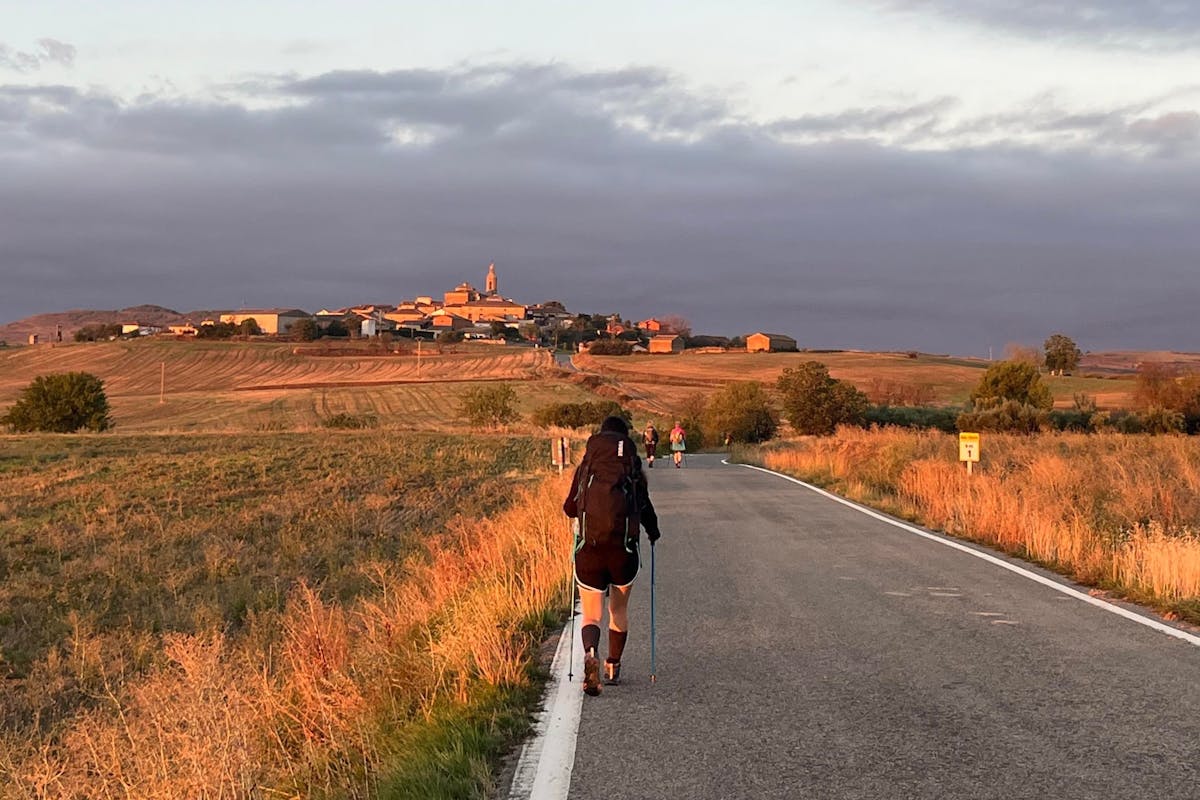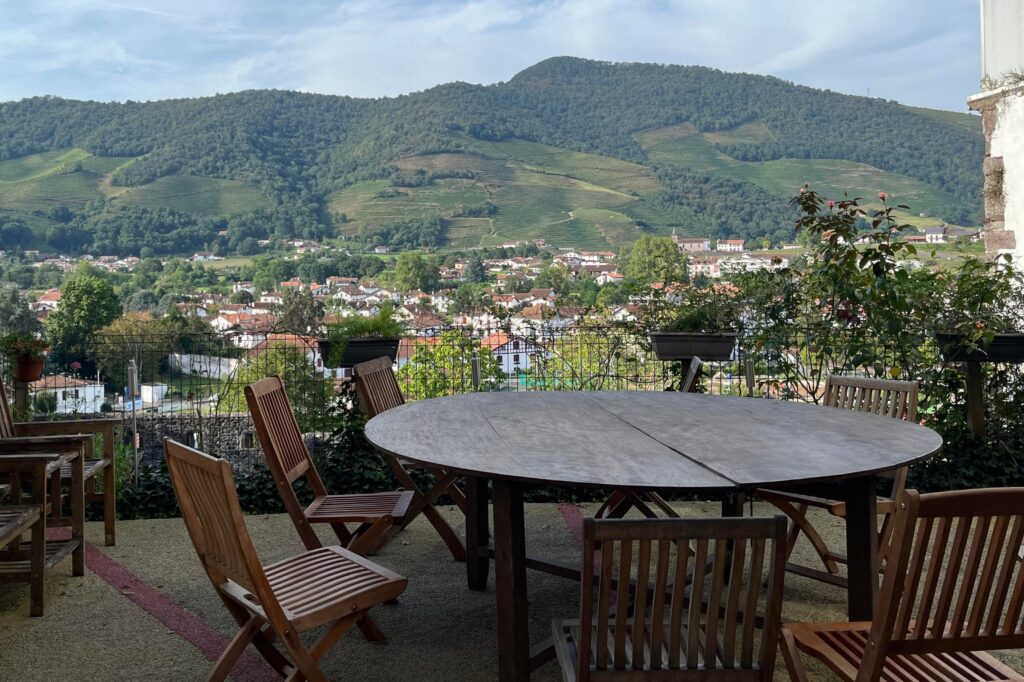The Camino Diaries, Week One: A Month on Spain’s Storied Camino to Santiago Compostela
From French Basque country, over the Pyrenees, and through the bullfighting Mecca of Pamplona to Logroño, the heart of Rioja country.

The lights come on at six that first morning. The soft snoring that had permeated much of the previous night turns to creaking beds and quiet groans as the eight people crammed into adjoining bunks at the 30-bed hostel contemplate the day ahead — 15-plus miles with an ascent of more than 3,000-foot over the Pyrenees into Spain. On foot. Saddled with a pack of slightly less than 15 pounds.
Breakfast is a microwaved egg tart, white toast, and instant coffee. The gathered “pilgrims” eat in silence, puffy and unrested. After breakfast, the owner of the hostel — a self-proclaimed “Camino addict” — stands us in a circle, holding hands, and tells us to “feel the moment” and “trust one another.” As we lace up our boots, he plays “Sweet Surrender” by John Denver from an iPhone speaker and hugs us goodbye.
We pilgrims spend the day dripping in sweat, pausing periodically on the side of the road for a breath, and counting the kilometers to the peak. The first day is a fairly average length, but one of the hardest climbs in the whole 500-mile walk. The mountains seem endless and the lush green fields begin to blend together halfway through the day— an older woman I meet from Holland remarks to me around noon, “Do you feel like we’ve seen this before?”
Although strenuous, Day One is also known as one of the most beautiful days. Cow bells tinkle and sheep shuffle alongside the path. A wild horse and her foal stop to graze beside us. After climbing most of the morning in silence, I notice after lunch that on the easier decline chatter picks up among the pilgrims with whom I would likely be spending a good chunk of the next month.

At the end of the day, a woman I recognized from breakfast charges into the monastery that has been converted into a dormitory for people on the Camino just before lights out, her sweat-soaked shirt clinging to her torso. As I open my mouth to ask how she is, she holds up a hand, silently shakes her head, and sits to peel off her socks. Around 3 a.m. the next morning, I hear her quietly pack her bag, get into a cab, and leave.
This is the Camino de Santiago, the way of St. James, a medieval pilgrimage dating back to the 9th century. It draws seekers from across the globe to the cathedral of Santiago de Compostela, where legend has it that the remains of St. James are buried. The trekkers are still labeled peregrinos, or pilgrims, though just as many seem to be doing it for secular, personal reasons as for religious ones.
Despite the intensity of the first day, and our exhaustion at the end of it, some unfortunate pilgrims are turned away from the monastery in Roncesvalles despite it being one of the largest hostels on the route, with more than 180 beds. The first night on the Camino Frances, the most popular of several distinct paths that criss-cross northern Spain, can also be the cruelest.

The modern Camino, especially in the busy month of September, has become what’s known by the pilgrims as a “bed race”— essentially, a race through the day to get a spot at an albergue, as the hostels that line the route are known. The unlucky ones at Roncesvalles and other stops are forced to walk to the next town more than an hour away to find a bed for the night.
A young Israeli woman I had fallen in with, on day three, narrows her eyes and whispers, “I don’t even see them as people anymore… only beds” as two people pass us on the trail, chirping the obligatory “Buen Camino!” as they go by.
According to the Camino Archives, in 1985 only 690 people walked the Camino. In 2022, the number was 437,507. The ritual is still saturated with spirituality and centered around religious sites along the path, but it’s become more than that now. For some, it’s a physical challenge; for others, a way to cope with grief.
For still others, it’s just an interesting YouTube vlog — on occasion we heard the quiet buzzing of an influencer’s drone soaring above our heads for a walking aerial shot. One albergue owner remarks that these pilgrims are known as “turigrinos” — more tourist than true pilgrim.
During my first week on the Camino, I walked with people from South Korea, Germany, Michigan, South Africa, New Zealand, Israel, and Japan. Many are retired, others freshly fired or searching for inspiration.

Although it’s common for other pilgrims to speak at least some English, you come across some with none, and yet still gravitate towards each other. I spend an entire dinner in Pamplona with a man from Seoul using Google Translate for each line of speech. We discuss the homes we grew up in, the politics of our countries, and the meals we find most comforting. On the Camino, no one is out of reach if you’re willing to put in the work.
After a week, we still have more than 400 miles to go. Between Pamplona and Logroño, the path is stunning: quiet, burbling creeks, pastures filled with grazing horses and cattle and lined with brambles brimming with perfectly ripened blackberries. One small town named Ayegui has not only a water fountain for pilgrims, but a fountain spewing the region’s famous Rioja red wine. Although it isn’t even 8 a.m., pilgrims huddle around it and fill scallop shells — the traditional icon of the Camino — with the wine to propel us through the first few miles of the morning.
Ahead awaits the dry Meseta, known as the biggest mental challenge of the Camino, notorious for its endless plains, harsh temperatures, and loneliness. Many pilgrims take buses to skip this section. Others claim that this is the section where most find the answers for which they are searching on the pilgrimage. I will not be hailing any taxis at any point on the route.

